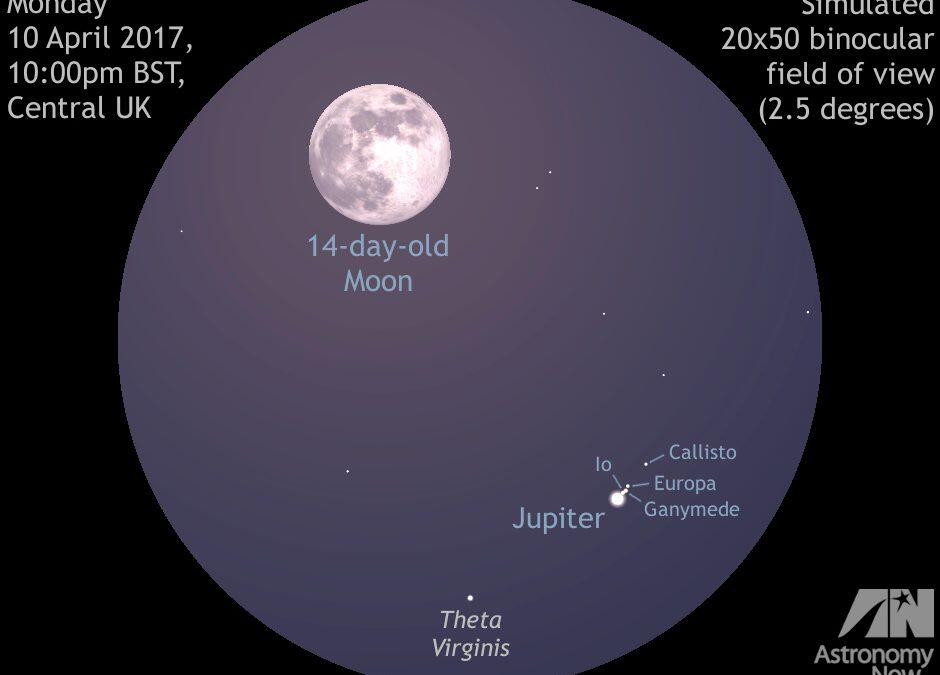As darkness falls around 10pm in early April for the UK, even casual stargazers cannot fail to notice the prominent magnitude -2.5 ‘star’ low in the southeast, an object that has more than twice the luminosity of brightest nighttime star Sirius sparkling low in the southwestern sky. Careful observation of the interloper in the southeast reveals that it is moving slowly with respect to the background stars of Virgo from night to night. This object is Jupiter — the largest planet in the Solar System.
Jupiter reaches opposition to the Sun on the evening of 7 April and lies closest to Earth at 21:28 UT the following night — some 4.4549 astronomical units, or 414.1 million miles (666.4 million kilometres) from our planet. This is when Jupiter’s angular size peaks at 44.3 arcseconds, meaning that a telescope employing little more than 42x magnification is required to enlarge Jupiter to the same apparent size as the full Moon seen with the unaided eye.
Jupiter is more massive than of all the other known planets of the Sun’s family combined. Eleven times the diameter of our planet, more than 1,300 Earth’s could comfortably fit within its enormous bulk. This planetary behemoth is largely composed of hydrogen and helium under gaseous and liquid states. Jupiter’s composition and fast rotation period of under ten hours give it a noticeably pot-bellied appearance.
A world with turbulent weather systems, Jupiter’s upper cloud layers provide an ever-changing tableau for owners of four-inch (10-centimetre) telescopes and larger when the planet is highest in the sky (currently about 1am BST for the centre of the British Isles) and seeing conditions are good.
The Great Red Spot (GRS) is an anticyclonic storm that has been observed for around 400 years. Our Almanac gives predictions for the best times you can see the GRS. Note that the Almanac’s predictions are in Universal Time (UT) for a global audience; British Jupiter watchers presently need to add one hour to these times. As a quick summary for UK-based observers, the GRS is well placed for observation on the following nights and British Summer Times:
As befits the King of the Planets, Jupiter is accompanied by an impressive retinue of 67 natural satellites at the last count. The largest of these by far are the so-called Galilean moons — Io, Europa, Ganymede and Callisto — discovered by Galileo Galilei in 1609/1610. Europa, the smallest of the ‘big four’, has a diameter slightly less than our own Moon, whereas the largest (Ganymede) exceeds planet Mercury in size. The Galilean moons are so conspicuous that quality binoculars will reveal them when furthest from their parent planet (see the illustration at the top of this page for 10 April).
Io, Europa, Ganymede and Callisto continually play cat and mouse as their orbital motion cause them to alternately pass in front of (transit) Jupiter or be hidden (occulted) by their parent planet or its shadow. Furthermore, the shadows of the Galilean moons frequently fall on the cloud tops of Jupiter, visible in modest (3-inch, or 7½-centimetre aperture) telescopes of good quality at magnifications of 100x or more as inky black dots slowly drifting across the face of the planet.
Predictions for the beginning and end times of Galilean shadow transits, plus information on their eclipses and occultations for any given date, may also be obtained through our Almanac. To see the satellite events for any given day, ensure that the ‘Add phenomena of Jupiter?’ checkbox is ticked. Like the Great Red Spot predictions, all Galilean moon phenomena events are in Universal Time (UT). For help using the Almanac.
Source: http://bit.ly/2oGV1pI














